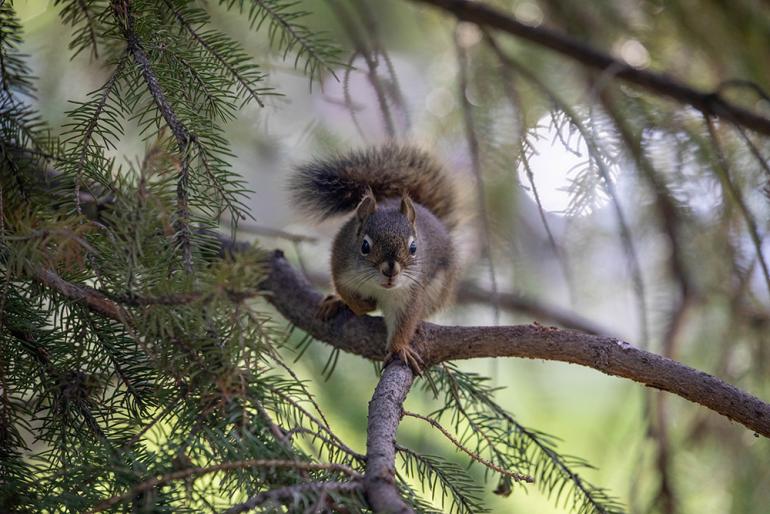Squirrel Talk
One hunting season, I was creeping toward a mature mule deer buck. I inched in, wind in my face, the lone bachelor still in his bed. Then, high up in a lodgepole pine, an obviously irritated pine squirrel leaned out onto a branch, looked down at me, and let out a raucous chatter that echoed through the hills. Now alert, the buck spotted me and with a few bounds was out of sight and most likely in the next county. I glared at the squirrel and scoffed at his reddish brown overcoat and fat off-white paunch separated by an annoying little belt of black fur. He must have known what I was thinking, and he matched my expletives with a barrage of his own squeaks, rolled R’s, and growls. “What was the big idea,” I wondered. “I wasn’t doing anything to that squirrel.” But as it turns out, I was.
Pine squirrels, also known as red squirrels, barking squirrels, and chickarees, are highly territorial. Studies have shown that some territories can be as large as two and a half acres for just one squirrel, so it’s unlikely you could walk in the woods very far without imposing. When the squirrels emit their sometimes-cute but often ill-timed chatter, they are simply defending their territory. But what exactly are they defending?
Pine squirrels in Montana live mainly on the cones of trees like lodgepoles and spruce. They can usually be found sawing off the unopened cones and letting them spiral downward, ending with a resounding thunk on the ground, a car, or a tent. They then gather the cones and protect their stashes with distinctive calls.
Somewhere within their territory, usually around a bountiful nut or cone-producing tree, pine squirrels cache their food. The squirrels prefer a technique called larder hoarding where they stash the goods in one big pile at the center of their territory. These “middens” can usually be found by looking for piles of cone debris under a squirrel’s nesting tree. Within the midden they bury uneaten cones in multiple layers of 20-30 cones each. They can get big—one midden in Colorado was 33 feet long and 4 feet wide.
Like most squirrels, the pine squirrel has an innate ability to store different foods at just the right temperature. Pinecones are often harvested while they are still green and unopened. They’re tightly packed into damp areas to keep the seeds from ripening and drying out. Some squirrels even hide their goods in small ponds and streams. Mushrooms, a favorite treat for most squirrels, are dried on small branches before being stored inside the relatively dry confines of a tree trunk.
Because squirrels rely on the caches of nuts, cones, and mushrooms for their survival, their annoyance at intruders is easy to understand. The next time I get harassed by a really miffed pine squirrel, I’m going to ask myself one question: What would I do if I found a stranger snooping around my refrigerator? I just might bark out a few expletives myself.






